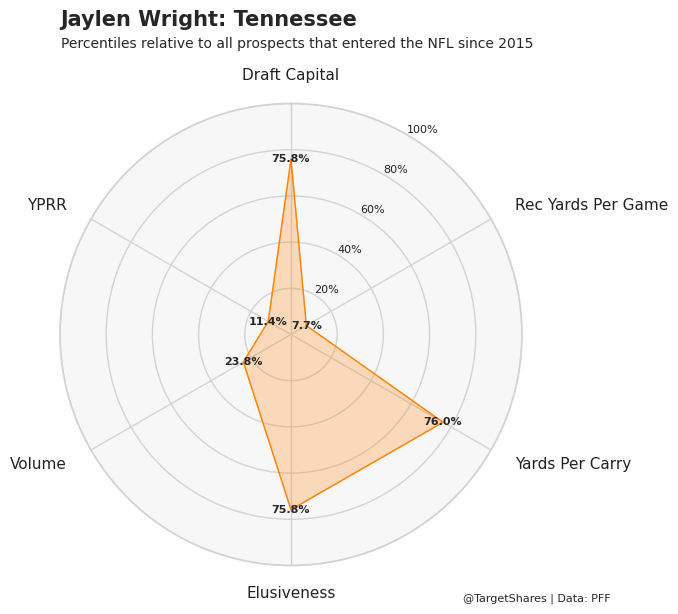Can Explosive RB Jaylen Wright Be Special? Maaaybe.
RB Jaylen Wright – Tennessee
5’11” | 210 lbs.
Career Stats: (rushing) 367 att 2,297 yds 18 TD (receiving) 30 rec 171 yds 0 td
Pros
Speed. Yes, Jaylen Wright has it. But folks telling you he is “just a speed guy” are selling him short.
None of Wright’s other traits are elite/near-elite, like his speed (Bruce Feldman’s 2022 Freaks List). But he does enough things well enough to have a role in the NFL and solid fantasy football results. Wright was invited to the Senior Bowl and came out after year 3 with limited early and overall production. This means the NFL likes him.
Wright is a decisive north-south runner who displays good vision and the ability to both get to the edge and accelerate when in the second level. He has good footwork and he is strong and physical for his size. Wright has pretty good lateral movement, identifies cutback lanes well, and has a good jump cut. He usually gets into the second level quickly and is a chunk play waiting to happen (25.5% of his 2023 attempts went for 10 or more yards).
Embed from Getty ImagesWright has NFL size and is just under the 30.0 BMI we like at the position (29.3). He is not great at pass protection but identifies blitzes well and is more than serviceable relative to the rest of the class. Wright lacked heavy receiving volume in college but was reliable enough when used in that phase.
Lance Zierlein gave Wright a film score of 6.33, second among running backs. His total NFL Next Gen Stats score is 79, fourth at the position.
Analytically, Wright doesn’t meet a lot of age-adjusted production thresholds, especially early. However, his year 3 breakout was impressive. Those 2023 highlights include: 1.40 ryoe/a, 8% receptions share, 7.4 ypc (career 6.3), 4.35 yco/a (among the best in the class), .32 mtf/a, 52.1 bay%, 132.2 PFF elusiveness grade, and a 91.2 PFF rush grade.
After his showing at the combine (4.38 40-yard dash, 38″ vertical jump, 11’2″ broad jump), Wright’s weight-adjusted speed score (WASS) is 114.1 (you want 100+), and his relative athletic score (RAS) is 9.82 out of 10. (numbers per PFF and Campus2Canton)

Cons
Like all running backs in this class, Wright has flaws. While Josh Heupel’s Tennessee offense is “funky” and employed a heavy RBBC rotation, Wright’s overall and especially early production is suboptimal. Very much related to that, his overall workload was never great.
It’s also worth noting that, at least partly due to that scheme, most of Wright’s success came against light boxes.
In fact, as Rich Hribar of Sharp Football Analysis notes, “Wright only logged 35.8% of his team rushes, 22nd in this class. 81.0% of his runs came against light boxes (six or fewer defenders), which was the highest rate in this class. On those runs, Wright averaged a robust 8.0 yards per carry. Wright only managed 25 total runs against boxes with seven or more defenders per Sports Info Solutions. On those runs, he averaged 4.8 YPC, which was 16th in this class.”
Wright’s size, physicality, and contact balance are generally good, especially at the second level (where he is also more elusive). However, if you get to Wright early, he can be in trouble. On that point, Hribar adds, “When Wright was hit at or behind the line of scrimmage, he averaged only 1.1 YPC, ahead of only three backs in this draft class. On runs when first contact came beyond the line of scrimmage, he averaged a class-high 10.6 YPC.”
Embed from Getty ImagesFrom a more general analytical perspective, the volume/production flaws cited above show up in Wright’s numbers. The lack of a more robust receiving profile also hurts him. For example, his career y/rr is 0.66; we’d like to see 1.5 or higher. His best season mark was only 1.33.
Interestingly, the lack of early volume shows up in suboptimal career efficiency numbers such as 3.72 yco/a and 0.26 mtf/a. Both are below his year 3 levels.
Finally, while the 40 time was very good, the 1.55 10-split was not. That’s especially true when we consider a.) that’s the area from shortly behind the line of scrimmage to shortly after – where he has issues, as noted above, and b.) it’s the same time as Theo Johnson, a 6’6″ 257-pound tight end. (numbers per PFF and Campus2Canton)
Summary
Jaylen Wright is an explosive, dynamic, scheme-versatile running back with big play ability and a high ceiling relative to most of the rookies at his position.
He’s currently my RB2 (16th overall in superflex), in tier 1A with other backs who have some combination of dynamism, a high ceiling (relative to the class), and at least somewhat of a path to a three-down role (Jonathon Brooks, Marshawn Lloyd, and Trey Benson).
However, for Wright to reach that ceiling, it appears he will need a good offensive line to keep him clean into the second level on an offense that will often face lighter boxes.
He will also need to increase his usage near the goal line and/or in the receiving game — aka earn high-value touches. The NFL may be a “get our guys the ball in space” league, which will benefit Wright, but it’s probably not enough for him to truly hit for fantasy. If he ends up as an 8-12 touches per game player, we will have to adjust our expectations even lower.
The running back class is packed in tight, and dynasty fantasy football rankers have minimal consensus on their pre-draft rankings at the position. As we’ve said the whole time, draft capital and landing spot will determine a lot for running backs, especially this year. (For more of my thoughts on the “over-hated” 2024 running back class, see this thread and this one.)
Some interesting outcomes include a likely 1A in Dallas (picks 56 and 87), a lightning role (for now) in Baltimore (62, 93, 113), an Elijah Mitchell replacement (for now) in San Francisco (63, 94, 132, 135), Zamir White insurance/competition (for now) in Las Vegas (77, 112), a speedy 1A while Gus Edwards is the bruiser (for now) on the Chargers (69, 105, 140), and a speed compliment and/or a 1A over Singletary (for now) for the Giants (70, 107, 141).
Strengths
- speed and explosive plays
- NFL size
- elusiveness (especially in the second level)
- overall strength, physicality, contact balance
Concerns
- situational strength, physicality, contact balance
- nuance, refinement near the line of scrimmage
- lack of early production and overall receiving volume
2024 Dynasty Rookie Draft Projection: 2nd to mid-3rd round in a 12-team, superflex, tight end premium format
Ideal Role: speed back/change-of-pace back with upside for 1A/three-down role
Player Comp: Travis Etienne, Tevin Coleman, Melvin Gordon, Kenneth Walker, Ty Chandler



